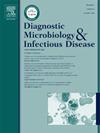Fever of unknown origin: Clinical significance of the etiology and common inflammatory parameters
IF 2.1
4区 医学
Q3 INFECTIOUS DISEASES
Diagnostic microbiology and infectious disease
Pub Date : 2025-03-12
DOI:10.1016/j.diagmicrobio.2025.116801
引用次数: 0
Abstract
Objectives
To analyze the fever of unknown origin (FUO) etiology and clinical characteristics and determine the diagnostic value of common inflammatory parameters.
Methods
A total of 853 patients with classic FUO were prospectively enrolled from January 2014 to May 2021. According to the etiological diagnosis, the patients were divided according to etiology: infectious diseases (n = 430); non-infectious inflammatory diseases [NIIDs] (n = 153); neoplastic diseases (n = 125); miscellaneous diseases (n = 48); and no identifiable etiology (n = 97). The clinical features and common inflammatory parameters were analyzed.
Results
The clinical characteristics and common inflammatory parameters varied among the FUO patients with different etiologies. The tuberculosis T lymphocyte spot test (T-SPOT.TB) and C-reactive protein (CRP) level might be used as indicators to diagnose infections in patients with FUO. Female gender, young age, high white blood cell (WBC) count and percentage of neutrophil percent (NP), high erythrocyte sedimentation rate (ESR), and elevated serum ferritin (SF) level contributed to the diagnosis of NIIDs. Male gender, old age, low hemoglobin (HB) concentration and platelet (PLT) count, and high lactate dehydrogenase (LDH) and SF levels contributed to the diagnosis of neoplastic diseases. Male gender, old age, and low LDH and SF levels contributed to the diagnosis of infectious diseases. The procalcitonin (PCT) and interleukin-6 (IL-6) levels were highest in FUO patients with neoplastic diseases.
Conclusions
Infectious diseases are the most frequent cause of FUO, followed by NIIDs. The clinical characteristics and common inflammatory markers have significant value in determining the etiology of FUO.
不明原因发热:病因及常见炎症参数的临床意义
目的分析不明原因发热(FUO)的病因及临床特点,探讨常见炎症参数的诊断价值。方法2014年1月至2021年5月,前瞻性纳入853例经典FUO患者。根据病因诊断,将患者按病因分类:感染性疾病430例;非感染性炎症性疾病[NIIDs] (n = 153);肿瘤疾病(n = 125);杂病(n = 48);病因不明(n = 97)。分析其临床特点及常见炎症参数。结果不同病因的FUO患者的临床特征和常见炎症参数存在差异。结核T淋巴细胞斑点试验(T- spot . tb)和c反应蛋白(CRP)水平可作为诊断FUO患者感染的指标。女性、年轻、白细胞(WBC)计数和中性粒细胞百分比(NP)高、红细胞沉降率(ESR)高、血清铁蛋白(SF)水平升高是NIIDs的诊断因素。男性、老年、低血红蛋白(HB)浓度和血小板(PLT)计数、高乳酸脱氢酶(LDH)和SF水平有助于肿瘤疾病的诊断。男性、老年、低LDH和SF水平有助于传染病的诊断。伴有肿瘤疾病的FUO患者降钙素原(PCT)和白细胞介素-6 (IL-6)水平最高。结论感染性疾病是引起FUO的最常见原因,其次是NIIDs。临床特征及常见炎症标志物对确定FUO的病因有重要价值。
本文章由计算机程序翻译,如有差异,请以英文原文为准。
求助全文
约1分钟内获得全文
求助全文
来源期刊
CiteScore
5.30
自引率
3.40%
发文量
149
审稿时长
56 days
期刊介绍:
Diagnostic Microbiology and Infectious Disease keeps you informed of the latest developments in clinical microbiology and the diagnosis and treatment of infectious diseases. Packed with rigorously peer-reviewed articles and studies in bacteriology, immunology, immunoserology, infectious diseases, mycology, parasitology, and virology, the journal examines new procedures, unusual cases, controversial issues, and important new literature. Diagnostic Microbiology and Infectious Disease distinguished independent editorial board, consisting of experts from many medical specialties, ensures you extensive and authoritative coverage.

 求助内容:
求助内容: 应助结果提醒方式:
应助结果提醒方式:


